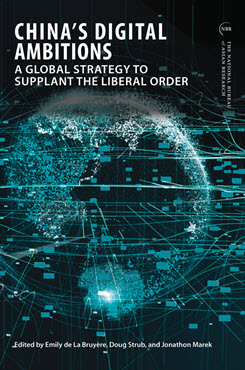Capturing the Virtual Domain
The Expansion of Chinese Digital Platforms
This chapter examines how the Chinese government is seeking to create a China-centered global digital order in which China’s technology firms have a leadership position and China controls or influences key economic, financial, information, trade, manufacturing, innovation, and technology networks; their supporting digital infrastructure; and information that flows through these digital platforms.
Download the full report in: French | Japanese | Korean.
Download the Executive Brief in: French | Japanese | Korean.
The project also features an interactive data tool for visualizing the global reach of China’s digital ambitions and the relationships between different forms of Chinese digital influence: Access the data tool here.
EXECUTIVE SUMMARY
MAIN ARGUMENT
China’s digital platforms are the likely place where the full range of China’s technology, economic, and geopolitical efforts, if successful, could converge and solidify China’s position in global markets. These platforms advance the Chinese government’s global ambitions as conveyed through its Belt and Road Initiative and related Digital Silk Road plans and seek to leverage and integrate the hard and soft infrastructure that China’s firms have established or acquired overseas. Through digital platforms, China seeks to operationalize its technology development efforts across the entire value chain in hardware, software, and related design, manufacturing, infrastructure, and services.
POLICY IMPLICATIONS
- The Chinese state plays a powerful and growing role in China’s digital infrastructure and operations. As China’s digital platforms expand overseas, these points of control allow the state to access, analyze, and leverage wide swaths of global data across a range of platforms and applications with far-ranging potential ramifications for China’s global economic and geopolitical capabilities.
- The Chinese government restricts foreign participation in its digital market, the largest in the world, allowing Chinese firms to secure a global leadership position in China and expand globally through sustained unfair trade and investment practices. These persistent asymmetries due to digital protectionism and state controls allow China to secure a global market position that could become increasingly difficult and costly to counter over time.
- China’s use of ostensibly nonprofit and corporate actors to advance state goals challenges key tenets of the global trading system and other countries’ abilities to address risks. Many markets are open to commerce, and most policy tools consider Chinese corporate actions on a case-by-case basis in narrow instances of national security risks, allowing governments to miss or dismiss the strategic ramifications of China’s early discrete actions.
Karen M. Sutter is a Specialist in Asian Trade and Finance at the Congressional Research Service. She previously worked at the U.S. Department of Treasury, the CIA, the U.S.-China Business Council, and the Atlantic Council, and has over 30 years of experience working on U.S.-Asia policy issues and crosscutting economic, political, technological, and national security issues in government, business, and the think tank community.
NOTE: The views expressed in this chapter are those of its author and are not presented as those of the Congressional Research Service or the Library of Congress.
About Asia Policy
Asia Policy is a peer-reviewed scholarly journal presenting policy-relevant academic research on the Asia-Pacific that draws clear and concise conclusions useful to today’s policymakers. Asia Policy is published quarterly in January, April, July, and October and accepts submissions on a rolling basis. Learn more



 Identifying and Countering China’s Global Digital Strategy (Paris)
Identifying and Countering China’s Global Digital Strategy (Paris)
